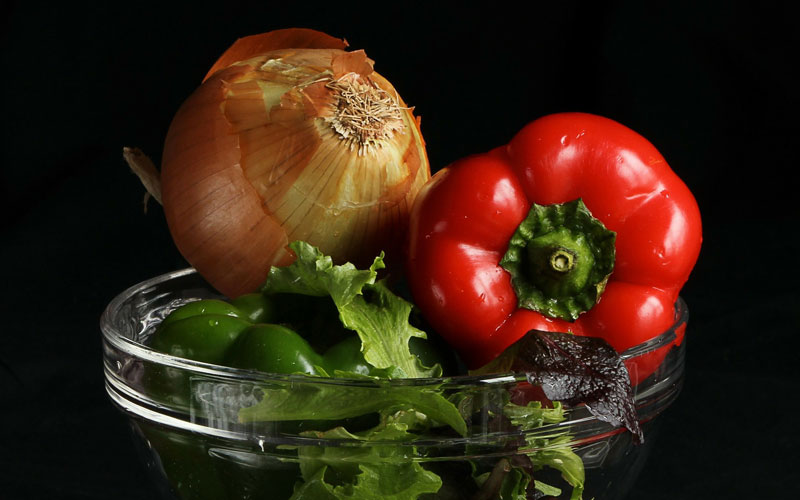The Hidden Toxins in Food

When most people think about a Paleo Diet, they think it is a healthy diet, rich in whole foods, sans dairy and grains.
But one important and sometimes overlooked aspect is the ‘low toxin burden’.
Avoiding processed foods, artificial ingredients, and excessive pesticides and herbicides is at the very least prudent.
There are many toxins, dietary, environmental, and otherwise, that are readily stored in your body. This was demonstrated in epic fashion, by accident, during Biosphere 2.
The Biosphere Experiments
Biosphere 1 is the Earth.
Biosphere 2 was an enormous, man-made, Earth-like structure that was completely closed off from the outside world.
It was constructed to see, among other things, if a small group of people could be completely self-sufficient.
On some levels, due in part to poor planning, it failed – food and oxygen needed to be added from the outside. However, eight volunteers still lived inside and collected data for two years.6, 7
The participants subsisted primarily on agriculture, but they were not able to provide enough food to sustain themselves.
They could only raise approximately 1,800 of the estimated 2,500 calories necessary to maintain weight. As such, all of them lost weight.
Their food was organic, herbicide, pesticide-free, and very nutrient-dense – all aspects in line with the principles of a Paleo Diet, and far different from their usual diet.
The thing that stuck with me since I visited the site over a decade ago is this: PCBs are synthetic organic chemicals, classified as Persistent Organic Pollutants.
DDE is a breakdown product of the insecticide DDT. Both are toxins.8
However, their exposure to these toxins should have been extremely low.
So why did they suddenly appear in their blood?
These toxins, like many others found in processed and/or inorganic foods, plastics, etc., can be stored in the body.
As the participants lost weight, the toxins were released from storage and eventually excreted.4
The second concept is what these toxins can potentially do to your health and quality of life.
A large body of research implicates food additives and environmental toxins as causal agents in the obesity epidemic.2
Not in the sense that they cause massive rapid weight gain overnight, but rather they cause the pancreas to secrete just a little more insulin than necessary, predisposing it to insulin resistance and the accumulation of body fat.2
Food additives, emulsifiers, preservatives, and even some artificial sweeteners have been shown to possess this ability.5
If you’re trying to gain weight, avoid toxins (dietary or otherwise):
1) to ensure a high ratio of muscle to fat mass; and
2) because some of those toxins may be stored. On the flip side, if you’re trying to lose weight, avoid toxins (dietary or otherwise) to prevent insulin hyper-secretion which could decrease the rate of fat loss and slow down your progress.
William Lagakos, Ph.D.
Dr. William Lagakos received a Ph.D. in Nutritional Biochemistry and Physiology from Rutgers University where his research focused on dietary fat assimilation and integrated energy metabolism.
His postdoctoral research at the University of California, San Diego, centered on obesity, inflammation, and insulin resistance.
Dr. William Lagakos has authored numerous manuscripts that have been published in peer-reviewed journals, as well as a non-fiction book titled ‘The Poor, Misunderstood Calorie’ which explores the concept of calories and simultaneously explains how hormones and the neuro-endocrine response to foods regulate nutrient partitioning.
He is presently a nutritional sciences researcher, consultant, and blogger.
References
1. Corkey BE. Banting lecture 2011: hyperinsulinemia: cause or consequence? Diabetes. Jan 2012;61(1):4-13.
2. Corkey BE. Diabetes: have we got it all wrong? Insulin hypersecretion and food additives: cause of obesity and diabetes? Diabetes Care. Dec 2012;35(12):2432-2437.
3. Dedios, John. Bio2_Sunset_001. Digital image. Wikipedia Creative Commons. Wikipedia, 30 Sept. 2011.
4. Imbeault P, Chevrier J, Dewailly E, Ayotte P, Despres JP, Tremblay A, Mauriege P. Increase in plasma pollutant levels in response to weight loss in humans is related to in vitro subcutaneous adipocyte basal lipolysis. Int J Obes Relat Metab Disord. Nov 2001;25(11):1585-1591.
5. Saadeh M, Ferrante TC, Kane A, Shirihai O, Corkey BE, Deeney JT. Reactive oxygen species stimulate insulin secretion in rat pancreatic islets: studies using mono-oleoyl-glycerol. PLoS One. 2012;7(1):e30200.
6. Walford RL, Mock D, MacCallum T, Laseter JL. Physiologic changes in humans subjected to severe, selective calorie restriction for two years in biosphere 2: health, aging, and toxicological perspectives. Toxicol Sci. Dec 1999;52(2 Suppl):61-65.
7. Walford RL, Mock D, Verdery R, MacCallum T. Calorie restriction in biosphere 2: alterations in physiologic, hematologic, hormonal, and biochemical parameters in humans restricted for a 2-year period. J Gerontol A Biol Sci Med Sci. Jun 2002;57(6):B211-224.
8. Wang SL, Tsai PC, Yang CY, Guo YL. Increased risk of diabetes and polychlorinated biphenyls and dioxins: a 24-year follow-up study of the Yucheng cohort. Diabetes Care. Aug 2008;31(8):1574-1579.
9. Weyer, Christian, Roy L. Walford, Inge T. Harper, Mike Milner, Taber MacCallum, P. A. Tataranni, and Eric Ravussin. “Energy Metabolism after 2 Y of Energy Restriction: The Biosphere 2 Experiment.” American Journal of Clinical Nutrition 53rd ser. 72.946 (2000): 1-8. Print.